October 23, 2020
Last week, my neighbor emailed that a second Kolea had arrived in her yard, annoying the resident Kolea to no end. Ruth wrote, “The two have been performing, running around at each other, and occasionally going after each other airborne. Is this usual? We are so accustomed to one, and only one, out here, ever.”
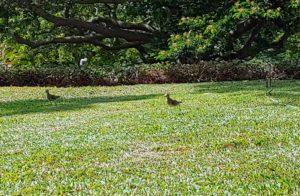
This Kailua Kolea fending off a newcomer. The staked leash on the right is for Ruth’s pet cat that is not allowed to roam free. (Thank you for that, Ruth, and for the pictures and story.)
Another reader, Denise, wrote, “Is it possible for 2 Kolea to be time-sharing the use of our back yard?” Initially, the first arrival (second year there) chased the other, but soon the two came to an agreement: One forages in the yard mornings; the other takes afternoons. At night, the two, nicknamed Astrid and Daisy, sleep peacefully together on the rooftop.
Without ID bands on the birds’ legs, it’s impossible to know for sure, but it’s likely that the summer’s offspring are arriving from Alaska. New Kolea appearances are normal in October and even November.
After performing their parental duties on the tundra, Hawaii’s adult Kolea begin returning to the Islands in August, leaving their chicks to fend for themselves.
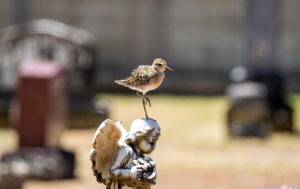
Professional photographer, Rick Bernico, shared his lovely September picture of two angels in Oahu Cemetery. © Rick Bernico
The chicks can fly by August, but stay behind for as long as berries and bugs are abundant on the tundra. But when snow falls, or when the youngsters have fattened up enough make their first migration, they head south, guided only by instinct.
It’s a demanding journey, and only the fittest, and the luckiest, of the summer’s chicks reach Hawaii or other Pacific islands. But finding land, a remarkable feat in itself, isn’t the end of the struggle. The skinny, exhausted juveniles must find food fast or starve to death. And when a bug-and-worm-rich territory is already spoken for, even by other bird species, fights can breaks out.
Most Kolea are fiercely territorial, tolerating no other birds their space. Another plover fan, Ted, wrote that at Bellows he watched a Kolea run back and forth in its patch, chasing off two cattle egrets on one side, and two Hawaiian stilts on the other. The Kolea had an invisible do-not-cross line that didn’t change as long as Ted watched.
Some individuals, however, are more social, foraging in pairs or small flocks. I know a pair that forage in the grassy area of Mokuleia Beach Park, sometimes flying to the beach together to search for invertebrates in the sand.
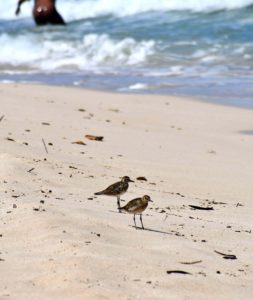
These two Kolea live up to their shorebird name at Mokuleia Beach Park. ©Susan Scott
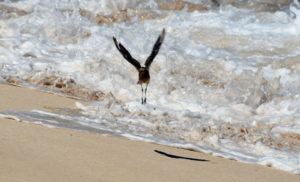
A large wave surprised one bird as it probed the sand for shrimp and crabs. The other saw it coming and ran up the beach. ©Susan Scott
Like humans, dogs, and most other animals, each Kolea has its own personality. Some will accept food from people just a few feet away, and others flee at the slightest disturbance. The Kolea in the North Shore polo field, for instance, are comfortable around trotting horses, a resident dog, and lawn mowers.
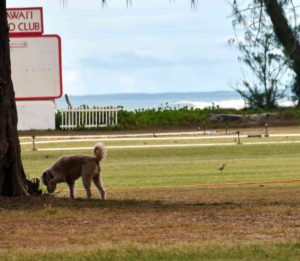
Kolea at the Hawaii Polo Club ignore the resident (mellow) dog. ©Susan Scott
At nearby Dillingham Air Field, though, when I stop my bicycle for a better look, those Kolea run or fly away.
In nearly all cases, after airplanes, bicycles, parachutists, golfers, leaf blowers, joggers, and other disturbances pass, the birds come back to their tried-and-true territory. This individual commitment to one particular foraging place, called being “site faithful,” is the reason we can be pretty sure we aren’t counting the same Kolea over and over. It’s also the reason we sometimes see fights.
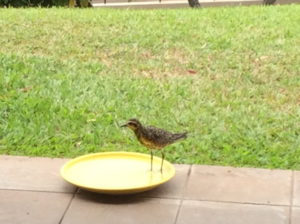
Maile the Kolea returns year after year to the this yard where she bathes and drinks from this dish. The owner, Joanne, keeps the bird’s water fresh.
If a new kid in town loses a skirmish, it will move on and hopefully find an unoccupied spot with ample food. And if another Kolea is already there, well, the two may strike a deal and share.
We don’t always know what a Kolea will do, but then, that’s part of the fun of watching them.
Thank you all for sharing for stories and pictures. (More about Kolea at http://koleacount.org)
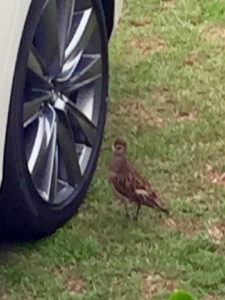
Michael Lilly of Laie shared this photo of his Kolea squaring off with the bird in the hubcap. A short video showed it attacking its own reflection.